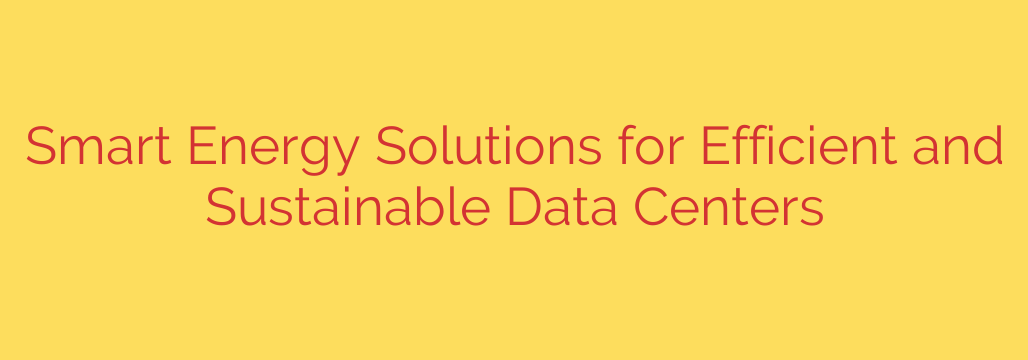
Powering the Future: A Guide to Building Sustainable and Energy-Efficient Data Centers
Data centers are the invisible engines of our digital world, powering everything from streaming services and cloud computing to the global financial system. As our reliance on data grows exponentially, so does the energy footprint of these critical facilities. The challenge is clear: how can we meet the ever-increasing demand for data while minimizing environmental impact and controlling operational costs? The answer lies in building smarter, more sustainable, and highly efficient data centers.
For forward-thinking organizations, energy efficiency is no longer a “nice-to-have”—it’s a core component of a resilient and competitive business strategy. A move toward sustainability not only reduces a facility’s carbon footprint but also delivers significant financial benefits through lower energy bills and improved operational stability.
Understanding the Core Challenge: Power and Cooling
A typical data center’s energy consumption is dominated by two main areas: the IT equipment itself (servers, storage, networking gear) and the infrastructure required to cool it. In fact, cooling systems can account for up to 40% of a data center’s total electricity usage. This makes optimizing cooling and power management the most critical first step toward efficiency.
A key metric for measuring this efficiency is Power Usage Effectiveness (PUE). PUE is a ratio that compares the total amount of power consumed by a data center to the power delivered directly to IT equipment. An ideal PUE is 1.0, meaning every watt of energy goes to the computing hardware. While a perfect 1.0 is practically impossible, the goal is to get as close to it as you can. Traditional, inefficient data centers might have a PUE of 2.0 or higher, while modern, optimized facilities can achieve a PUE of 1.2 or even lower.
Advanced Cooling Strategies: Moving Beyond Traditional Air Conditioning
Brute-force air conditioning is an outdated and incredibly inefficient way to cool a high-density computing environment. Modern data centers are adopting more intelligent approaches to thermal management.
Hot/Cold Aisle Containment: This is a fundamental and highly effective design strategy. By physically separating the cold air intake aisles from the hot air exhaust aisles, you prevent hot and cold air from mixing. This simple separation allows you to increase the temperature of the cooling air, which dramatically reduces the energy load on your computer room air conditioners (CRACs). Implementing aisle containment can cut cooling energy costs by 20-40%.
Liquid Cooling: As server racks become more densely packed with powerful processors, air cooling is reaching its physical limits. Liquid cooling offers a far more efficient alternative.
- Direct-to-Chip Cooling: This method involves circulating a liquid coolant through pipes directly to a cold plate attached to the hottest components, like CPUs and GPUs.
- Immersion Cooling: For maximum efficiency, entire servers are submerged in a non-conductive, dielectric fluid that absorbs heat directly from all components. Liquid is thousands of times more effective at transferring heat than air, leading to massive energy savings and enabling much higher server density.
Free Cooling: In suitable climates, facilities can use outside air to cool the data center, either directly or indirectly through a heat exchanger. When outdoor temperatures are low enough, this method can partially or completely replace energy-intensive mechanical refrigeration for hundreds or even thousands of hours per year.
Intelligent Power Management and Monitoring
You can’t manage what you don’t measure. Gaining granular visibility into power consumption is essential for identifying waste and optimizing performance.
Data Center Infrastructure Management (DCIM): DCIM software is the central nervous system of a modern data center. It provides a holistic view of the facility’s operations, integrating data from power meters, temperature sensors, and IT systems. With DCIM, operators can monitor PUE in real-time, track energy consumption down to the individual rack or server level, and proactively identify “ghost servers” (servers that are plugged in and consuming power but doing no useful work).
Smart Power Distribution Units (PDUs): Modern rack PDUs do more than just distribute power. These intelligent devices provide real-time metering of voltage, current, and power consumption for each outlet. This data feeds directly into the DCIM system, allowing for precise load balancing and capacity planning.
The Role of AI and Automation
Artificial intelligence is transforming data center operations from reactive to predictive. AI algorithms can analyze vast amounts of data from thousands of sensors to make real-time adjustments that optimize efficiency.
For example, an AI-driven management system can predict workload fluctuations and proactively adjust cooling levels in specific zones, ensuring that energy is only used where and when it’s needed. This level of dynamic control is impossible to achieve with manual oversight and leads to significant energy reductions without compromising reliability.
Embracing Renewable Energy
To achieve true sustainability, data centers must look beyond internal efficiencies and focus on the source of their power. Integrating renewable energy is a crucial step in decarbonizing operations.
While building on-site solar or wind farms is an option for some, many organizations are turning to Power Purchase Agreements (PPAs). Through a PPA, a company agrees to purchase energy from a renewable energy provider at a fixed rate over a long term. This helps finance new solar or wind projects and allows the data center to claim the environmental benefits of clean energy, even if the renewable source is off-site.
By combining intelligent facility design, advanced monitoring, AI-powered automation, and a commitment to renewable energy, we can build the data centers of the future. These facilities will not only power our digital lives but will do so in a way that is financially prudent, operationally resilient, and environmentally responsible.
Source: https://feedpress.me/link/23606/17106521/driving-efficiency-and-sustainability-in-data-centers-with-smart-energy-solutions








